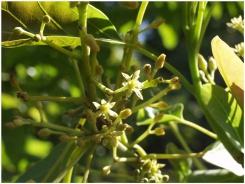Blossoming of California avocado trees can occur from late winter through early summer, but most harvested fruit develop from flowers that are pollinated during two months in spring. Spring flowering is, in fact, a stressful time for a California avocado tree because flowers require a lot of resources — sugars, starch, water, nutrients — in order to maximize fruit set.
It’s important to walk through the avocado groves during spring flowering in order to ensure each flowering avocado tree is receiving adequate water and nutrition. Assessing the trees will also help you note weak flowering rates of flowering so that you can identify the causes and plan ahead to avoid a repeat of poor flowering.
The most common cause of poor flowering on avocado trees — the alternate bearing cycle.
Unlike deciduous fruit trees, avocado trees never go dormant, thus avocado trees have three concurrent growth cycles. They are developing the current year’s fruit and providing nutrients and resources that mature the fruit for harvest. They are supporting the needs of the year two fruit set that will be harvested the following year. And they are producing new shoots and buds that will produce either vegetative or floral buds for the year three harvest.
Because it takes two years to develop an avocado fruit from bud break to maturity, the amount of fruit harvested in the current year is a result of cumulative weather and cultural management influences in the preceding two years. Flowering is also affected by events in the previous years.
Avocado trees also have a tendency to develop alternate bearing cycles result in on-crop harvests (large amount of fruit) followed by off-crop harvests (minimal amount of fruit). This alternate bearing cycle is the most common cause of poor flowering.
In an on-crop year, an avocado tree is likely to produce fewer peripheral new shoots because the majority of its resources are dedicated to supporting the large amount of fruit. Fewer new shoots one year means less avocado fruit the next year because avocado trees only flower, set fruit and bear fruit on peripheral new shoots. At times, avocado crops have been heavy enough to cause two years of poor flowering and yields, resulting in a large third-year crop, as the tree seeks to find its "balance" among growth, fruit and future flowering.
To reduce the negative effect on avocado production, it is generally recommended that two avocado cultural management practices be followed. First, ensure the avocado trees have the nutrients they need for good flowering and yields. Second, ensure that overwintered leaves remain healthy for as long as possible throughout flowering and fruit set.
To determine the exact amounts and times of applying fertilizers you must monitor your grove, take notes and use a specialist who will perform soil, leaf and water tests. The specialist will determine amounts based on fruit load, cropping history, growth cycles, soil/leaf/water tests and existing regulations. Remember — irrigation water contains nutrients as well and this must be factored into your irrigation and fertilizer strategy. Fertilizer applications just before flower bud break are critical to leaf health, good flowering and avocado production, with special attention paid to trace elements that may be in short supply.
